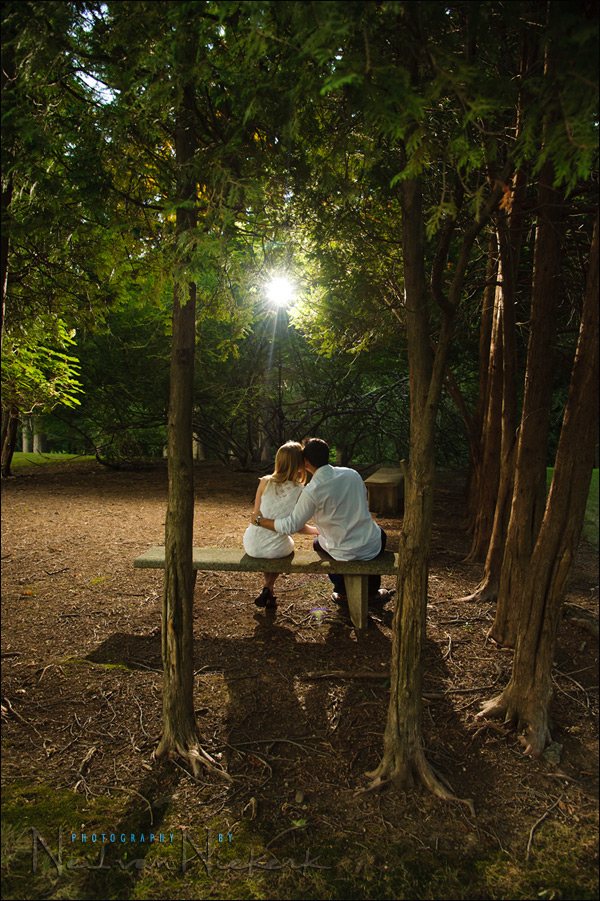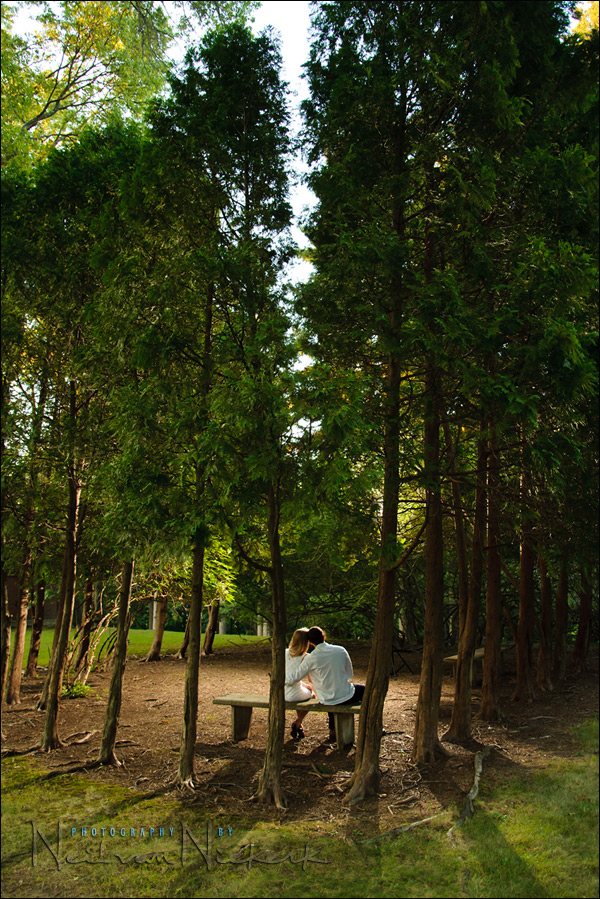
Off-camera flash for dramatic back-lighting
During this engagement photo session with a couple, Ashley and Michael, we roamed around the campus grounds of the university where they had met. In the one part of the grounds, there was this clump of trees, planted in a small rectangle with two seats. Since it was so dark there under the trees, they wondered who’d ever go and sit there. It just didn’t look appetizing. Then I though … hmmm, with some off-camera flash from behind, we can really make this place look like something.

This is the same place, taken at the same camera settings as above: 1/60 @ f5.0 @ 800 ISO … but without flash, it’s just dark. The direction of light is such that you’d have to position your subject outwards, and then the light would still not have been wonderful. The light levels would also have been too dark.
I immediately hoped that throwing a flash high-up above them, pointing down at where they are seated, would create an interesting radiating pattern of shadows from the trees. And it worked.
Since I didn’t have an assistant with me, I took a light stand with me in case I wanted to use an off-camera softbox. For the light-stand, I chose the Manfrotto 1004BAC – tall light-stand (affiliate) because of the large footprintand because of its extra weight. The extra weight helps on location where there is the possibility of wind.
So with the 12-foot tall light-stand at hand, I was able to hoist a speedlight up high, and tilt it slightly downwards. To have the speedlight give me a wide spread of light, I flipped down the wide-angle diffuser panel.
Here is a shot where I purposely included the flash, as a kind of pull-back shot.

The off-camera speedlight was trigged by the PocketWizard FlexTT5 & AC3 Controller I started off shooting in TTL mode, since this is the mode I most often shoot in when on location. But since the flash is used as back-lighting, it made more sense to have it as manual flash. Changing modes was a breeze with the AC3 Zone Controller.
In the end, I shot at full manual output. So the set-up was quite simple. Of course, any manual, flash triggered off-camera, would’ve worked.

To my eye, the vertical shot didn’t work as well as the horizontal image here. With so much of the blue sky revealed in the vertical image, the mystery and dramatic feel to the image is reduced. A higher shutter speed (e.g. maximum flash sync speed), might have done the trick here. But I didn’t go as far.

Related articles
- Off-camera flash – creating separation with back-lighting (model – Bethany)
- Off-camera flash – adding dimension with back-lighting (model Lea)
- More articles about off-camera flash photography
- More images from this photo session
Photo gear (or equivalents) used during this photo session
- Nikon D3
- Nikon 24-70mm f2.8G AF-S / Canon 24-70mm f/2.8L II
- (2x) Nikon SB-910 Speedlight controlled by PocketWizard FlexTT5 & AC3 Controller
or alternately, the Canon 600EX-RT Speedlite controlled by Canon ST-E3 Transmitter - Manfrotto 1004BAC – tall light-stand
Just a thought: I was wondering if you considered putting more light on the spot with the trees to the right (I am talking about the final, horizontal photo)? My first impression was that this part is too dark, as I wasn’t able to see any details there. Moreover, as it creates a dark spot on a well illuminated picture, it attracts eyes attention, even though there is nothing interesting over there. Otherwise, it is a very stunning picture, great lightning!
Holy crap Neil this one is blowing me away! It has a dream like quality to it. The post processing is perfect. LOVE!
Such clever thinking for that situation and amazing how much power can come from a single flash head. Can i ask if this was totally naked flash or did you use a CT gel to warm things up a little?
very nice! you continue to inspire me to think about the possibilities :)
When you say full manual output, do you mean M(+3, white) on the AC3?
No post processing!?? I would have sworn it had been hit with Lucis just a little. I’m loving it. You are making me jealous with this one!
Very clever idea.
I can see the foot of the lightstand in the final picture, but it’s very difficult to see. I’m not sure if people looking at it would notice or care, because the lighting moves the eye elsewhere.
When I first looked at the picture I thought it was the sunset! Really great picture.
Neil, when you bounce the light with the black foamie thing what is the usual zoom setting you use? Did you leave it at manual or do you set it close to 200mm? Any other recommendation regarding the distance of the wall?
Thanks.
Thanks and sorry for asking again.
wow! WELL DONE! Thank you for all the inspiration and knowledge you share with us. We surely don’t thank you enough!!!
Wonderful job!!! I much prefer the vertical shot.
Wow great idea!! Thanks for sharing. I didn’t notice at first, but once I got to the bottom of your post, the legs of your light stand really caught my eye. It’s very noticeable in the vertical shot.
simply awesome! really very cool shot! thanks for all the details Neil!
I just found your site today and I cant believe how much knowledge you share with everyone. Bravo to you. I am a photographer who recently began doing hindu weddings and I have a very basic equipment, one body, couple lenses, one flash with diffuser and I have had a hard time to decide one what to purchase next. I know that reading through your site I will be able to make these decisions more confidently. Thank you so much
This is the most wonderful shot I’ve seen recently, dear wizard with tho hats.
Neil, so how much power was pumped out by the SB-900 to illuminate all that area? One can never underestimate the speedlights. BTW, the Flex TT5 combo is becoming a regular feature in your shoots. You seem to be a happy camper with the Nikon version. I don’t think Canon shooters have exactly the same story to tell.
Brilliant! Thanks for the pullback!
Nice work Neil!
Although I am kind of surprised that you cropped the couple dead center in the image.
My preference would be to put the couple off to the left or right, falling at about a third of the frame. Remember the rule of thirds or Phi?
What a wonderfully well thought out and executed image. I love it. Thanks for sharing.
I always love reading your newsletters. You are very generous with knowledge.mthank you. I would love it if you would mention how you reach a good exposure with off camera flash. Thanks.